Hi all,
From time to time I stumble over guitar amps that show some strange volume control behavior: With volume fully turned down the amp plays at moderate volume, turning up the control just a little bit decreases volume to - almost! - zero, when turned up further, output volume increases again as you would expect.
I found out that this does not come from a faulty potentiometer (or any faulty part, I suppose) but from some unexpacted behavior of the tube used - always 12AX7.
I recently encountered this again on a Selmer Treble'n'Bass MkIII. The input stage looks like this (sorry for the quality):
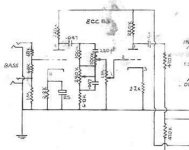
This is fairly straightforward, with the first half of the 12AX7 feeding the tone stack, then the signal goes to the volume pot before reaching the grid if the second system.
Now what happens, with volume turned fully down (and the grid of the second triode therefore grounded!), is that the input signal appears at the plate of the second triode system (marked "1"), with identical level as at the input, but, surprisingly, out of phase.
Now turn volume a little bit up: The reversed signal mixes with the desired signal until there is a point of almost full cancellation. Turning up further simply drowns the reversed signal until it is not noticeable any more.
Now this may sound like just some unwanted crosstalk, but there is more to it. First, it only seems to occur with 12AX7s or ECC83s (no matter what manufacturer).
It also is crucial that the first system has a bypassed cathode resistor while the second has not.
Shortly, the tube is obviously running under some abnormal operational state, with the second triode system behaving rather like a grounded grid circuit.
Remarkably, it is even possible to stop this phenomenon and restore normal working condition, namely during operation. Everything works like expected then - until the amp is being turned off. Let it cool down then for some minutes and it starts all over again.
I did some reserarch on what's happening and would be happy to share my experiences if someone is interested or has been dealing with this phenomenon too. I can come up with some more observations, values and scope screenshots. I suppose there is a name for it, but I have no idea where to look for...
Maybe someone even knows the correct term?
Cheers
Georg
From time to time I stumble over guitar amps that show some strange volume control behavior: With volume fully turned down the amp plays at moderate volume, turning up the control just a little bit decreases volume to - almost! - zero, when turned up further, output volume increases again as you would expect.
I found out that this does not come from a faulty potentiometer (or any faulty part, I suppose) but from some unexpacted behavior of the tube used - always 12AX7.
I recently encountered this again on a Selmer Treble'n'Bass MkIII. The input stage looks like this (sorry for the quality):

This is fairly straightforward, with the first half of the 12AX7 feeding the tone stack, then the signal goes to the volume pot before reaching the grid if the second system.
Now what happens, with volume turned fully down (and the grid of the second triode therefore grounded!), is that the input signal appears at the plate of the second triode system (marked "1"), with identical level as at the input, but, surprisingly, out of phase.
Now turn volume a little bit up: The reversed signal mixes with the desired signal until there is a point of almost full cancellation. Turning up further simply drowns the reversed signal until it is not noticeable any more.
Now this may sound like just some unwanted crosstalk, but there is more to it. First, it only seems to occur with 12AX7s or ECC83s (no matter what manufacturer).
It also is crucial that the first system has a bypassed cathode resistor while the second has not.
Shortly, the tube is obviously running under some abnormal operational state, with the second triode system behaving rather like a grounded grid circuit.
Remarkably, it is even possible to stop this phenomenon and restore normal working condition, namely during operation. Everything works like expected then - until the amp is being turned off. Let it cool down then for some minutes and it starts all over again.
I did some reserarch on what's happening and would be happy to share my experiences if someone is interested or has been dealing with this phenomenon too. I can come up with some more observations, values and scope screenshots. I suppose there is a name for it, but I have no idea where to look for...
Maybe someone even knows the correct term?
Cheers
Georg
GeorgK > possible to stop this phenomenon and restore normal working condition, namely during operation.
How? Playing? Knob?
When "nulled", is it a full-range null, boom, shrill, or variable?
The other possibility is excess ground resistance, but it would have to be >Kohm to be significant.
The third is stray capacitance. When I did a similar circuit, many high settings of Vol and Treb would squeal, until I poked pot-leads with a "Lead" pencil to find what made it squeal worse, and put more separation in there.
I would not think 50pFd a'-a''. Brimar sheet shows <1pFd. Page 2:
http://www.mif.pg.gda.pl/homepages/frank/sheets/184/1/12AX7.pdf
I don't have a 12AX7 and a C-meter at hand to test that.
How? Playing? Knob?
When "nulled", is it a full-range null, boom, shrill, or variable?
The other possibility is excess ground resistance, but it would have to be >Kohm to be significant.
The third is stray capacitance. When I did a similar circuit, many high settings of Vol and Treb would squeal, until I poked pot-leads with a "Lead" pencil to find what made it squeal worse, and put more separation in there.
I would not think 50pFd a'-a''. Brimar sheet shows <1pFd. Page 2:
http://www.mif.pg.gda.pl/homepages/frank/sheets/184/1/12AX7.pdf
I don't have a 12AX7 and a C-meter at hand to test that.
Hello guys,
thanks for your interest and replies.
The point is - I do not think it's merely stray capacitance causing some kind of crosstalk between the two systems. Let me come up with some more observations. Some of these make more sense, some less. The reason why I do not post them all together is that I think may be difficult to follow.
And yes, my first thought was some weak HT filtering. No success.
Grounding looks ok.
Now for the first measurements:
Here is the signal at the input and output, volume pot fully down. Frequency in all shots at about 500Hz, but this is not important.
Upper trace is the input, lower one the output at plate of V2.
Scaling: 100mV/div
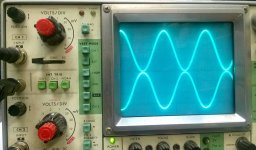
I find it remarkable that they are practically identical in level. Coincidence?
Anyway, this signal does not have lots of headroom. If you apply roughly 500mVRMS on the input, the output already looks severely distorted:
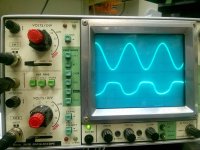
500mV/div
Now for the cancellation:
By turning up volume control a bit you can almost cancel the output signal.
As, other than the disturb signal, this desired signal has to pass the tone stack it is slightly phase shifted, so for best canellation you may have to adjust the tone controls.
The result looks like this:
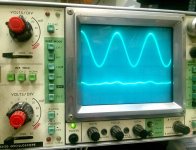
100mV/div
The cancellation works over a wide frequency range, but may be kind of distorted, as an undistorted but phase-shifted signal (the actual audio signal that goes through the tone stack!)is being mixed with a maybe overdriven but exactly 180 degrees-shifted disturb signal.
Now, for the weirder things:
To stop this you simply have to lower the plate voltage of V1 for a moment.
This can be done by either momentarily shorting V1's cathode resistor or removing the HT. You can also turn off the amp, wait for about 5 seconds and turn it on before the heaters have cooled down. Amp works as expected then.
You have to do this on V1.
Temporarily removing HT from V2 has no effect.
The point is, the selmer mk3 has a silicone rectifier but no standby switch.
You can fake the switch by removing the HT fuse when powering up and put in the fuse after some seconds.
Obviously the phenomenon only occurs when HT is applied to "cold" tubes.
I have some more, but I have to leave this for this evening.
Cheers,
Georg
thanks for your interest and replies.
The point is - I do not think it's merely stray capacitance causing some kind of crosstalk between the two systems. Let me come up with some more observations. Some of these make more sense, some less. The reason why I do not post them all together is that I think may be difficult to follow.
And yes, my first thought was some weak HT filtering. No success.
Grounding looks ok.
Now for the first measurements:
Here is the signal at the input and output, volume pot fully down. Frequency in all shots at about 500Hz, but this is not important.
Upper trace is the input, lower one the output at plate of V2.
Scaling: 100mV/div

I find it remarkable that they are practically identical in level. Coincidence?
Anyway, this signal does not have lots of headroom. If you apply roughly 500mVRMS on the input, the output already looks severely distorted:

500mV/div
Now for the cancellation:
By turning up volume control a bit you can almost cancel the output signal.
As, other than the disturb signal, this desired signal has to pass the tone stack it is slightly phase shifted, so for best canellation you may have to adjust the tone controls.
The result looks like this:

100mV/div
The cancellation works over a wide frequency range, but may be kind of distorted, as an undistorted but phase-shifted signal (the actual audio signal that goes through the tone stack!)is being mixed with a maybe overdriven but exactly 180 degrees-shifted disturb signal.
Now, for the weirder things:
To stop this you simply have to lower the plate voltage of V1 for a moment.
This can be done by either momentarily shorting V1's cathode resistor or removing the HT. You can also turn off the amp, wait for about 5 seconds and turn it on before the heaters have cooled down. Amp works as expected then.
You have to do this on V1.
Temporarily removing HT from V2 has no effect.
The point is, the selmer mk3 has a silicone rectifier but no standby switch.
You can fake the switch by removing the HT fuse when powering up and put in the fuse after some seconds.
Obviously the phenomenon only occurs when HT is applied to "cold" tubes.
I have some more, but I have to leave this for this evening.
Cheers,
Georg
Last edited:
...
I would not think 50pFd a'-a''. Brimar sheet shows <1pFd. Page 2:
http://www.mif.pg.gda.pl/homepages/frank/sheets/184/1/12AX7.pdf
I don't have a 12AX7 and a C-meter at hand to test that.
Yes, sorry, my memory playing silly tricks! There is a long and interesting thread about it here:
Crosstalk between Triodes in Dual Triode Tubes
I think the '50' that I remembered was actually -50dB of cross-talk - Dohhh!
Nothing special here...
Ug=0V (of course, it is almost perfectly grounded by the volume pot)
Uc=1,8V
Maybe one point that makes the Selmer special is that it runs with rather high voltages, HT at the plate resistor is about 410V, and of course even higher when the heater is cold.
The resulting plate voltage during operation is about 215V.
This is the case for both systems.
Ug=0V (of course, it is almost perfectly grounded by the volume pot)
Uc=1,8V
Maybe one point that makes the Selmer special is that it runs with rather high voltages, HT at the plate resistor is about 410V, and of course even higher when the heater is cold.
The resulting plate voltage during operation is about 215V.
This is the case for both systems.
Yes, and it actually is there. You can find an "input" signal on the cathode.
In fact, V2 seems to operate like a grounded grid circuit. Output on the plate is in-phase with the signal on the cathode (and out of phase with the actual input). Remember, V2 has a non-bypassed cathode resistor.
I did not take a photo because the input signal trace looks quite noisy on my scope and is hard to capture on a photo, but it is obviously being fully amplified.
What happens when turning up volume slightly is that you apply a signal of roughly (tone stack!) the same phase to the grid of V2. Eventually, as you would expect, the output signal is being "cancelled" at the plate as soon as they are of equal level.
Questions are:
Where is that signal at the cathode coming from while the grid ist grounded by the pot? I think I can rule out the HV supply. Adding an additional filter cap changed nothing, and there is no signal visible on the supply.
And why does this stop when HV supply to v1(!) is being interrupted for a moment (or to be more exact, plate voltage is shortly lowered?
I tested this with different makes of 12AX7 and they all show the same effect.
Install let's say a 12AT7 and everything is fine.
btw, the ubiquitous Shuguang-made 12AX7 looks exactly like their 12AT7, so I would expect roughly the same plate-to-plate capacitance. Probably they just differ in their grid winding. I tested both. 12AT7 does not show the effect.
In fact, V2 seems to operate like a grounded grid circuit. Output on the plate is in-phase with the signal on the cathode (and out of phase with the actual input). Remember, V2 has a non-bypassed cathode resistor.
I did not take a photo because the input signal trace looks quite noisy on my scope and is hard to capture on a photo, but it is obviously being fully amplified.
What happens when turning up volume slightly is that you apply a signal of roughly (tone stack!) the same phase to the grid of V2. Eventually, as you would expect, the output signal is being "cancelled" at the plate as soon as they are of equal level.
Questions are:
Where is that signal at the cathode coming from while the grid ist grounded by the pot? I think I can rule out the HV supply. Adding an additional filter cap changed nothing, and there is no signal visible on the supply.
And why does this stop when HV supply to v1(!) is being interrupted for a moment (or to be more exact, plate voltage is shortly lowered?
I tested this with different makes of 12AX7 and they all show the same effect.
Install let's say a 12AT7 and everything is fine.
btw, the ubiquitous Shuguang-made 12AX7 looks exactly like their 12AT7, so I would expect roughly the same plate-to-plate capacitance. Probably they just differ in their grid winding. I tested both. 12AT7 does not show the effect.
Last edited:
...
Where is that signal at the cathode coming from ... ?
...
Any chance that the tag-board, or whatever the circuit is constructed on, has become conductive due to age and moisture absorption?
Well, I had thought of that...
Anyway, nothing I could measure with an Ohmmeter.
And how could this explain this weird behavior regarding powering up hot or cold filaments? Why can I make it go away as long as power is not turned off and on again? And why only with 12AX7?
Besides the input inpedance of the cathode is pretty low, so I rather do not think that a significant amount of signal could creep in there.
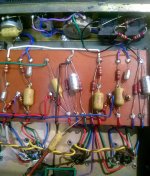
Here is a blurry photo of the input stage, the cap far right is V1 cathode resistor bypass, then Rc, Rc of V2, then plate resistors and decoupling caps of both systems. About in the middle of the pic you can see the components of the summing amp that comes after both input stages. Yes, the output of V1 is not too far away from the cathode of V2, but still... Bending the socket wires to different positions made no difference either.
I have to mention, I don't have the Selmer at hand any more. Everything I write down here comes from my notes.
But what I did try was to install a bypass cap over the cathode R of V2. Strange things happen:
If I install it with the amp powered off, the whole stage is ok. Overall Gain is higher of course.
But if I install it during operation (don't try this at home, folks! ), the signal on the cathode of course disappears but that signal on the output only gets lower by maybe 30 percent. Which makes me speculate that there is some crosstalk is happening (within the glass?) that still is modulating cathode current. Something that is only being triggered when power is switched on with cold tubes...
), the signal on the cathode of course disappears but that signal on the output only gets lower by maybe 30 percent. Which makes me speculate that there is some crosstalk is happening (within the glass?) that still is modulating cathode current. Something that is only being triggered when power is switched on with cold tubes...
Also, everything is fine here when V1 is running without bypass cathode cap. I suppose it has something to do with gain of v1 being lower then. Unfortunately I have failed to check what happens with the cap being removed under operation.
It is not the first tiime I see such a phenomenon. I remember a couple of years ago, I had a Fender Pro Junior on my bench that showed the same thing. I did not have the time to do more measurements as on the Selmer, but finally installing a 12AT7 helped.
What the Fender Pro jr. and the Selmer TNB mk3 have in common is the lack of a standby switch and a similar input stage, although the Fender has no cathode bypass cap on the first stage.
And I am aware of the fact that also Pro Junior players are commonly not plagued by such issues.
Cheers,
Georg
Anyway, nothing I could measure with an Ohmmeter.
And how could this explain this weird behavior regarding powering up hot or cold filaments? Why can I make it go away as long as power is not turned off and on again? And why only with 12AX7?
Besides the input inpedance of the cathode is pretty low, so I rather do not think that a significant amount of signal could creep in there.

Here is a blurry photo of the input stage, the cap far right is V1 cathode resistor bypass, then Rc, Rc of V2, then plate resistors and decoupling caps of both systems. About in the middle of the pic you can see the components of the summing amp that comes after both input stages. Yes, the output of V1 is not too far away from the cathode of V2, but still... Bending the socket wires to different positions made no difference either.
I have to mention, I don't have the Selmer at hand any more. Everything I write down here comes from my notes.
But what I did try was to install a bypass cap over the cathode R of V2. Strange things happen:
If I install it with the amp powered off, the whole stage is ok. Overall Gain is higher of course.
But if I install it during operation (don't try this at home, folks!
Also, everything is fine here when V1 is running without bypass cathode cap. I suppose it has something to do with gain of v1 being lower then. Unfortunately I have failed to check what happens with the cap being removed under operation.
It is not the first tiime I see such a phenomenon. I remember a couple of years ago, I had a Fender Pro Junior on my bench that showed the same thing. I did not have the time to do more measurements as on the Selmer, but finally installing a 12AT7 helped.
What the Fender Pro jr. and the Selmer TNB mk3 have in common is the lack of a standby switch and a similar input stage, although the Fender has no cathode bypass cap on the first stage.
And I am aware of the fact that also Pro Junior players are commonly not plagued by such issues.
Cheers,
Georg
Last edited:
... input and output, volume pot fully down. ...I find it remarkable that they are practically identical in level. ....
I think it remarkable it plays, audibly, with "volume pot fully down". Excusing the typical >-50dB pot leakage, I would expect "no" sound. Most buyers/users would. So there is A Fault.
Is this only with the one Selmer? All of this model? Other models? brands?
I would really be thinking a bad connection. Looks soldered. Isn't. I have seen that happen at the factory and the amp worked well and hard for years (before catching fire). I have seen many oxide "contacts" re-make after disruption, including supply cycling. Tube pins/sockets are prolific bad-contact points. Bad contacts *inside* resistors and caps are rare but possible.
Hi PRR,
thanks for your thoughts.
As I mentioned, I remember seeing a similar problem in a Fender Pro Junior.
Can't be a design problem regarding they must be produced in ten thousands a year.
It's not simply a matter of power-cycling, the difference obviously is whether the cathode is cold or pre-heated at the moment HT is applied.
I watched the "leak" signal at the moment when power is being turned off. For one or two seconds, as the voltages get lower, the signal decreases until a certain point is reached where it abruptly goes to zero. When the amp is being turned on again before this moment the leak signal stays. When turning it on afterwards (but before the heaters are fully cooled down) you get rid of it.
And as I mentioned, it has nothing to do with a leaking pot. This signal has not passed the tone stack (verified with square wave input) and appears at the plate of v2 with 180° phase shift.
Can be seen on either of both input channels, btw. They are identical except for the tone shaping.
Also not a matter of power supply load. Pulling the mixer tube and therefore kepping the signal away from the power amp does not change anything.
Is it a coincidence that, at low levels, it is exactly of the same level as the input? I don't think so.
In case of the Selmer, this is enough to let it play on, let's say, moderate bedroom volume.
The amp came to me for a different reason and the owner never bothered about it because he plays it loud only and never at home.
I do not think all Selmers suffer from this. The mk1 (and mk2 I think)has a tube rectifier and therefore is not prone of this anyway.
I even remember encountering something similar on my own 1968 Deluxe Reverb when trying out different (mostly old) input tubes. Did not investigate this any further because I thought it was a matter of the tubes used. As the Selmer is gone now I may have a chance to reproduce the effect on my amp.
Cheers,
Georg
thanks for your thoughts.
As I mentioned, I remember seeing a similar problem in a Fender Pro Junior.
Can't be a design problem regarding they must be produced in ten thousands a year.
It's not simply a matter of power-cycling, the difference obviously is whether the cathode is cold or pre-heated at the moment HT is applied.
I watched the "leak" signal at the moment when power is being turned off. For one or two seconds, as the voltages get lower, the signal decreases until a certain point is reached where it abruptly goes to zero. When the amp is being turned on again before this moment the leak signal stays. When turning it on afterwards (but before the heaters are fully cooled down) you get rid of it.
And as I mentioned, it has nothing to do with a leaking pot. This signal has not passed the tone stack (verified with square wave input) and appears at the plate of v2 with 180° phase shift.
Can be seen on either of both input channels, btw. They are identical except for the tone shaping.
Also not a matter of power supply load. Pulling the mixer tube and therefore kepping the signal away from the power amp does not change anything.
Is it a coincidence that, at low levels, it is exactly of the same level as the input? I don't think so.
In case of the Selmer, this is enough to let it play on, let's say, moderate bedroom volume.
The amp came to me for a different reason and the owner never bothered about it because he plays it loud only and never at home.
I do not think all Selmers suffer from this. The mk1 (and mk2 I think)has a tube rectifier and therefore is not prone of this anyway.
I even remember encountering something similar on my own 1968 Deluxe Reverb when trying out different (mostly old) input tubes. Did not investigate this any further because I thought it was a matter of the tubes used. As the Selmer is gone now I may have a chance to reproduce the effect on my amp.
Cheers,
Georg
Last edited:
- Status
- This old topic is closed. If you want to reopen this topic, contact a moderator using the "Report Post" button.
- Home
- Live Sound
- Instruments and Amps
- Strange volume control and tube behavior in 12AX7 twin-triode input stage